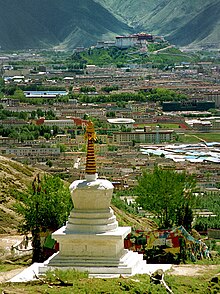Chupzang Nunnery
| Chupzang Nunnery | |
|---|---|

A panoramic view of Chubchang (Nunnery)
|
|
|
|
|
| Coordinates | 29°42′45″N 91°7′19″E / 29.71250°N 91.12194°ECoordinates: 29°42′45″N 91°7′19″E / 29.71250°N 91.12194°E |
| Monastery information | |
| Location | Lhasa Prefecture, Tibet, China |
| Founded | 1665 (formally 1696) |
| Type | Tibetan Buddhist |
| Colleges | Part of Sera Monastery |
Chupzang Nunnery (Chu bzang dgon) is a historical nunnery, belonging to Sera Monastery. It is located north of Lhasa in Tibet, China. Though the site was established as a hermitage around 1665, it was converted into an exclusive nunnery in 1984 and has since grown into one of the largest nunneries in the Lhasa Valley.
Chupzang, also spelt Chubzang, in Tibetan means "fresh water" or "good water" and is so-named because water is supplied by a natural spring.
The Chubzang Nunnery, located on the hill side, is situated to the northwest of Sera Monastery and to the north of Lhasa in the suburb of Nyang bran, at the base of the rocky canyon which is covered with shrubs. It is approachable by about a 1 kilometre (0.62 mi) path from Sera, which takes about 20 minutes to cover. It is also approachable from Trashi Chöling Hermitage from the south-east direction. As originally built, the hermitage (ri khrod) faces south. The layout of the hermitage has three components. The first part, on the extreme north, consists of a multitude of stupas (reliquaries) amidst painted rocks that depict craven images said to be ‘self-arisen’. The second part, which is the main hermitage complex, is to the south of the stupas and has the monastery with the Dharma courtyard (chosrwa), and a secondary temple. The third part, to the south of the temple complex, has a plethora of apartments, which are all privately owned by the nuns themselves.
The nunnery was originally a hermitage believed to have been founded by Trinlé Gyatso (Phrin las rgya mtsho) (d. 1667), who was the regent of Tibet from 1665 till his death. Trinlé Gyatso belonged to Nyangdren (in the suburb of Lhasa to the west of Sera). Trinlé Gyatso was a student of the Fifth Dalai Lama. He was also the uncle of Desi Sanggyé Gyatso (1653–1705), who was also a student of the Fifth Dalai Lama’s and who also became the regent of Tibet. It is also mentioned that the Fifth Dalai Lama wanted initially to favour Sanggyé Gyatso by appointing him as regent of Tibet. However, good counsel prevailed, and to avoid any public protests he appointed Trinlé Gyatso as the regent until his nephew gained more experience and attained maturity before becoming the regent. Then, Trinlé Gyatso, in the later part of his life, requested the Fifth Dalai Lama's permission to build a hermitage for eight monks initially (it is said that it was later increased to a core group of 16 ordained monks - 8 from each of the two colleges of Sera Je and Sera Me of Sera Monastery) in the foothills above his native Nyangbran and invited the Fifth Dalai Lama to perform a “site investigation” (sa brtag) to determine the most auspicious location on which to build the monastery. The Dalai Lama made the treasure (gter) discovery of the self-arisen stone image of the Buddha that is still located in Chupzang’s lower temple, and he also gave the name to the hermitage. However, the initial hermitage fell into ruin and the official founding of a new hermitage is credited to Phrin las rgya mtsho's nephew, Sde srid sangs rgyas rgya mtsho, in around 1696. The ruins of the original hermitage are still seen at the site. Chubzang was one of the five hermitages that belonged to Sera Me college; the other four were Pabonka, Jogbo, Tashi Choiling and Pinglung.
...
Wikipedia

